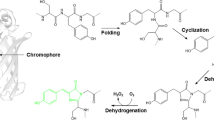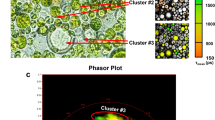Summary
In this paper we review our experiments on the light-induced Ca2+ release and proton uptake at the rod outer segment (ROS) disk membrane using flash-spectrophotometry and the indicating dyes arsenazo III and bromcresol purple. We used three different ROS preparations in order to locate the intracellular site of Ca2+ release. The ionophore A23187 was required to communicate the Ca2+ release to the indicator located in the external medium in both ROS with an intact and with a leaky plasma membrane. A23187 was also required to observe the Ca2+ released in the interior of vesicles prepared by sonication of ROS. From this we conclude that the site of Ca2+ release is located at the luminal side of the disk membrane, whereas this Ca2+ was not transported across the disk membrane under our experimental conditions and on the time scale of our experiments (20 s). Light-induced Ca2+ release was inhibited by electrolytes in the suspension medium provided that the electrolytes gained access to the compartment where Ca2+ was released. The effectivity to inhibit Ca2+ release markedly increased from monovalent to divalent to trivalent cations. The results strongly suggest that electrolytes (cations) act by screening the electrostatic potential at the disk membrane surface due to the presence of a net fixed negative surface charge. The surface potential controls the free Ca2+ concentration at the membrane surface and, therefore, controls the amount of Ca2+ bound to the disk membrane.
The kinetics of light-induced Ca2+ release and proton uptake showed a similar dependence on the structural status of the ROS. In sonicated ROS almost linear Arrhenius plots were observed for metarhodopsin II formation, Ca2+ release and proton uptake (energy of activation 150 kJ/ mol). In intact ROS both Ca2+ release and proton uptake showed a nonlinear Arrhenius plot with rate constants up to 30-fold slower than metarhodopsin II formation. At temperatures above 10 °C a process other than metarhodopsin II formation rate limited both light-induced proton uptake and Ca2+ release (energy of activation 42 kJ/ mol). A model is discussed in which metarhodopsin II formation triggers the uptake of proton(s) into the disk membrane lowering the surface potential. A reduction potential of the surface in turn decreases the free Ca2+ concentration at the surface thereby causing the release of part of the bound Ca2+.
Similar content being viewed by others
References
Fain, G. L. and Lisman, J. E., 1981. Prog. Biophys. Mol. Biol. 37: 91–147.
Kaupp, U. B. and Schnetkamp, P. P. M., 1982. Cell Calcium 3: 83–112.
Smith, H. G. and Bauer, P. J., 1979. Biochemistry 18: 5067–5073.
O'Brien, D. F., 1979. Photochem. Photobiol. 29: 679–685.
Shevchenko, T. F., 1976. Biophysics (Engl. Transl.) 21: 327–330.
Gold, G. H. and Korenbrot, J. I., 1981. Curr. Top. Membr. 15: 00–00.
Szuts, E. Z. and Cone, R. A., 1977. Biochim. Biophys. Acta 468: 194–208.
Kaupp, U. B., Schnetkamp, P. P. M. and Junge, W., 1979. Biochim. Biophys. Acta 552: 390–403.
Gold, G. H. and Korenbrot, J. I., 1980. Proc. Natl. Acad. Sci. U.S.A. 77: 5557–5561.
Yoshikami, S., George, J. S. and Hagins, W. A., 1980. Nature 286: 395–398.
Schnetkamp, P. P. M., 1980. Biochim. Biophys. Acta 498: 66–90.
Kaupp, U. B., Schnetkamp, P. P. M. and Junge, W., 1980. Nature 286: 638–640.
Kaupp, U. B., Schnetkamp, P. P. M. and Junge, W., 1981. Biochemistry 20: 5500–5510.
Kaupp, U. B., Schnetkamp, P. P. M. and Junge, W., 1981. Biochemistry 20: 5511–5516.
Schnetkamp, P. P. M., Klompmakers, A. A. and Daemen, F. J. M., 1979. Biochim. Biophys. Acta 552: 379–389.
Junge, W., 1976. Chem. Biochem. Plant Pigm., 2nd ed., pp. 233–333.
Kaupp, U. B., Schnetkamp, P. P. M. and Junge, W., 1979. In: Detection and Measurement of Free Ca2+ in Cells (Ashley, C. C. and Campbell, A. K., eds.), pp. 287–308, Amsterdam: Elsevier/North Holland.
Schnetkamp, P. P. M. and Daemen, F. J. M., 1982. Methods Enzymol. 81: 110–116.
Pfeiffer, D. R. and Lardy, H. A., 1976. Biochemistry 15: 935–943.
Schnetkamp, P. P. M., 1979. Biochim. Biophys. Acta 554: 441–459.
Fishman, M. I., Oberc, M. A., Hess, H. H. and Engel, W. K., 1977. Exp. Eye Res. 24: 341–353.
Schnetkamp, P. P. M., 1981. Biochemistry 20: 2449–2456.
McLaughlin, S., 1977. Curr. Top. Membr. Transp. 9: 71–144.
Eisenberg, M., Gresalfi, T. Riccio, T. and McLaughlin, S. 1979. Biochemistry 18: 5213–5223.
Cafiso, D. S. and Hubbell, W. L., 1980. Biophys. J. 30: 243–264.
Bennett, N., Michel-Villaz, M. and Dupont, Y., 1980. Eur. J. Biochem. 111: 105–110.
McConnell, D. G., Rafferty, C. N. and Dilley, D. A., 1968. J. Biol. Chem. 243: 5820–5826.
Emrich, H. M., 1971. Z. Naturforsch. B 26: 352–356.
Bennett, N., 1978. Biochem. Biophys. Res. Comm. 83: 457–465.
Bennett, N., 1980. Eur. J. Biochem. 111: 99–103.
Author information
Authors and Affiliations
Rights and permissions
About this article
Cite this article
Schnetkampa, P.P.M., Kaupp, U.B. On the relation between rapid light-induced Ca2+ release and proton uptake in rod outer segment disk membranes. Mol Cell Biochem 52, 37–48 (1983). https://doi.org/10.1007/BF00230587
Received:
Issue Date:
DOI: https://doi.org/10.1007/BF00230587




